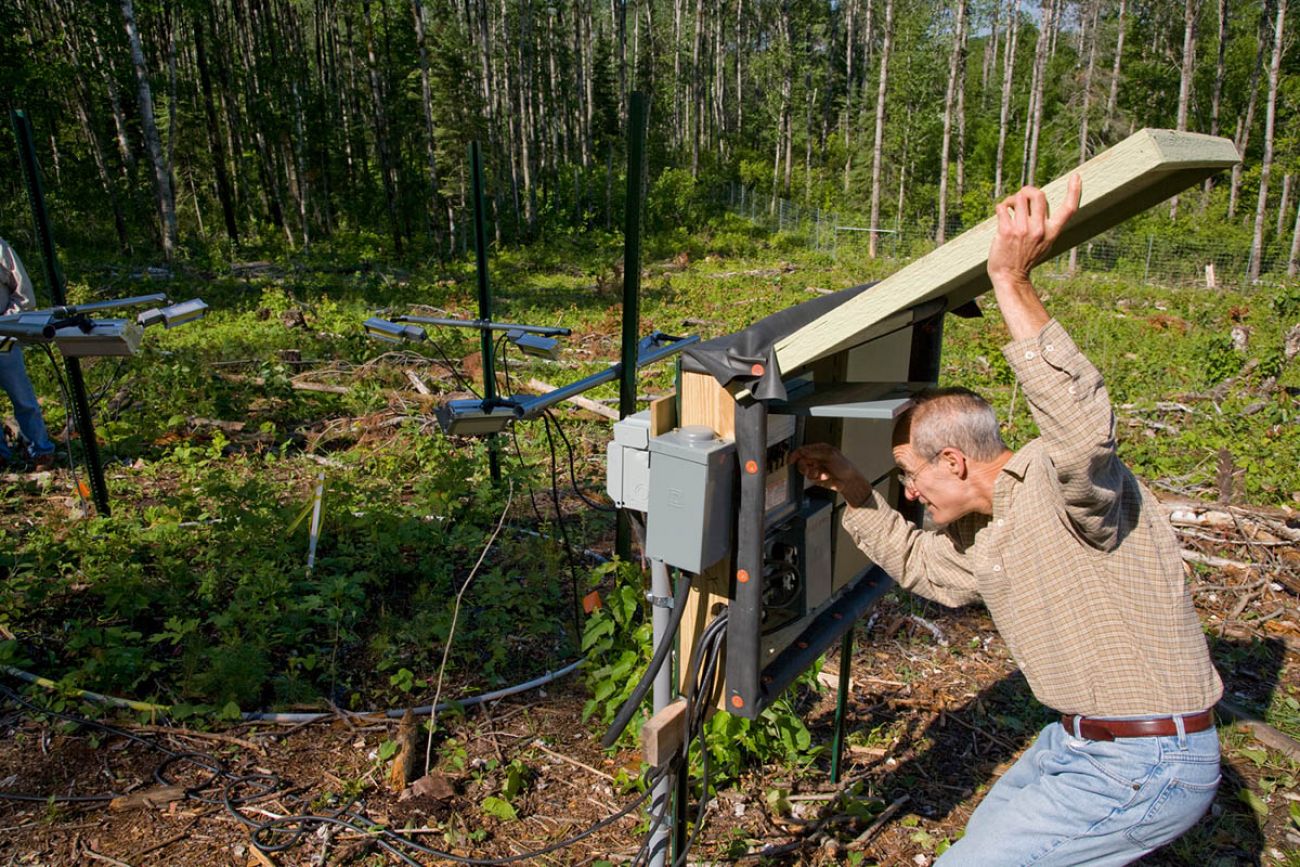Under current climate trends, Michigan’s Up North forests could be doomed

- Researchers used lamps, heating cables and tarps to test saplings in warmer and drier conditions
- Warming of just 2.9 degrees Fahrenheit would cause trees including fir, spruce and cedar to die
- Climate change could replace Michigan’s northern forests with southern trees and invasive weeds.
Michigan’s boreal forests — the thick stands of fir, spruce, cedar and other northern species that define the far northern woods — are in trouble unless world nations get more aggressive about ditching fossil fuels.
That’s a disturbing takeaway from a new study led by researchers at the University of Michigan and University of Minnesota, published this month in the journal Nature.
Using infrared lamps, underground heating cables and overhead tarps placed at research plots in the woods of northern Minnesota, researchers subjected saplings of nine boreal species to warming of either 2.9 degrees or 5.6 degrees Fahrenheit (1.6 degrees or 3.1 degrees Celsius) above ambient temperature, along with varying levels of rainfall.
Related:
- As northern Michigan warms, scientists bring tree seedlings from the south
- Report: Lake Michigan is ‘running a fever.’ More storms, less fish possible.
Those temperatures mimic conditions society can expect under two scenarios: A future in which global nations meet ambitious targets to stop adding greenhouse gasses to the atmosphere by midcentury, and one in which society clings to fossil fuels for longer, resulting in faster and more intense warming.
The results are disconcerting: Even under 2.9 degrees of warming — a threshold the world is guaranteed to surpass if world nations stick to their existing climate action plans — death rates rose an average of 50 percent in four of the nine tree species studied. Cold-loving conifers fared the worst, though virtually every species suffered when heat was combined with lower rainfall that’s also likely to affect boreal forests as climate change brings more summer droughts.
Bridge Michigan spoke with Peter Reich, director of U-M’s Institute for Global Change Biology and the study’s lead researcher, about what the findings mean for Michigan and the rest of the northwoods. Responses have been edited for length and clarity.

It’s no surprise that warming would harm cold-loving species. What inspired you to study the extent of that harm?
Ecologists already know from ground plots and satellite imagery that trees are not doing well in the transition zone between temperate and boreal forests of North America, Siberia and Scandinavia. In southern Canada, for instance, spruce and fir have grown poorly for the last 40 or 50 years, and died more frequently.
There’s a lot of things going on that could be driving that, from changing temperature and precipitation, to more insects, disease and wildfires, and changes in forest management. So pointing the finger at what’s responsible for the ongoing changes is a hard thing to do. So we were inspired to try to test some ideas about whether or not forests would be sensitive to what we’re anticipating for the future.
What you found is concerning. Did it surprise you?
I was actually surprised. You think oh, less than three degrees Fahrenheit. If it’s 78 degrees out today, and it was 75 yesterday, it’s hard as a human to notice the difference. I thought trees wouldn’t really notice it either, and that maybe we’d see a few percentage points of decline in growth and survival. So we were shocked to find 20, 30, 40 percent declines.
The trees aren’t responding to the temperature alone, but to the fact that in a warmer world, plants and soils lose more water. A one-degree Celsius (1.8 degrees Fahrenheit) increase in temperature causes 7 percent more evaporation and transpiration from plants and soils, so you need 7 percent more rain just to offset the loss.
In essence, the future is going to be functionally drier for plants, even if we get the same amount of rain. And we’re actually predicted to get more rain in the winter and spring, but less in the summer when it’s hot, and more of it in the form of larger rain events where a lot of the moisture runs off without soaking into the soil.
Why is that uptick in temperature so deadly for boreal forests in particular?
People tend to think, well, shouldn’t climate change have its greatest impact where it’s already hot and dry? But these trees evolved for cold conditions: really cold winters, short growing seasons and mild summer temperatures. And at the southern edge of the boreal forest, places like northern Michigan, trees are already sensitive because they’re on the warmer margins of what those species are evolutionarily and physiologically suited to.
But all trees are not created equal. In our experiment the temperate species, like oaks and maples, often grew faster with the warming, particularly when there was enough rain. That’s because right now, in northern Michigan and Minnesota, those trees are on the cold edge of their range.
So how long do we have before the conifers start disappearing, and the oaks and maples shift northward?
That depends. If we keep doing business as usual, and the world gets another degree Celsius (1.8 degrees Fahrenheit) warmer in 30 or 40 years, our forests may really start to suffer.
Now, our experiment was with young trees, which generally are more sensitive than larger trees. So what we’ll lose first is the forests’ capacity to regenerate. But eventually, the large trees will start to succumb to the same conditions as the seedlings.
Just last night I got an email from a colleague who’s working with the U.S. Forest Inventory Data, a census of all the large trees in the country, and they’re already seeing these effects. It’s already happening, and it’s going to get worse in the future.
In a perfect world, oaks and maples would spread rapidly enough to replace the spruce and fir — in other words, we’d keep healthy forests where we replace the trees that are no longer adapted to heat with ones that are. The problem is these species don’t colonize that rapidly, and we don’t have the economic wherewithal to go and do widespread adaptive management, or planting climate-adapted trees throughout all these forests.
So what we’ll have instead is failure of some of the current species, and a slow colonization by weeds and shrubs, including maybe some invasive species that are moving north faster than oaks and maples.
That can’t be good for the animals that inhabit those forests. And our northern forests are such an economic driver in rural communities where logging and outdoor recreation are big employers. What’s the possible toll of forest loss?
It all depends how rapidly forest growth slows. If trees are just growing more slowly due to heat, but you can still replace them, it’s going to be a more modest loss of timber production. But even a three, four, five percent hit can have a huge impact, because the southern boreal forest covers a huge area in Siberia, Canada and the U.S. And then there’s tourism, which is a big deal in some northern communities and is dependent upon healthy forests.
But what I think is most important, is that boreal and tropical forests have been providing literally quadrillions of dollars-worth of ecosystem services to humanity over the last 70 years, by soaking up carbon that we put into the atmosphere by burning fossil fuels. In doing that, those forests and the ocean have slowed climate change by more than half.
When forests die, they release that stored carbon dioxide back into the atmosphere. So whether our forests continue to grow and help us, or actually start to die and hurt us, is a huge issue for our economy, our ecosystems and life itself.
Michigan Environment Watch
Michigan Environment Watch examines how public policy, industry, and other factors interact with the state’s trove of natural resources.
- See full coverage
- Subscribe
- Share tips and questions with Bridge environment reporter Kelly House
Michigan Environment Watch is made possible by generous financial support from:
Our generous Environment Watch underwriters encourage Bridge Michigan readers to also support civic journalism by becoming Bridge members. Please consider joining today.
See what new members are saying about why they donated to Bridge Michigan:
- “In order for this information to be accurate and unbiased it must be underwritten by its readers, not by special interests.” - Larry S.
- “Not many other media sources report on the topics Bridge does.” - Susan B.
- “Your journalism is outstanding and rare these days.” - Mark S.
If you want to ensure the future of nonpartisan, nonprofit Michigan journalism, please become a member today. You, too, will be asked why you donated and maybe we'll feature your quote next time!






